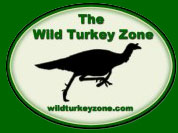|

T.R.'s
Tips: Turkey Biology & Behavior
Vision
 Vision
scientist, Dr. Jay Neitz believes that birds see in
trichromatic color like humans, and that many birds
actually see four colors. He also believes that some
birds see ultraviolet light as a different color than
any of the three primary colors of red, yellow and
blue seen by humans. Birds detect ultraviolet light
in low light conditions that humans can't, especially
birds that are night predators. Vision
scientist, Dr. Jay Neitz believes that birds see in
trichromatic color like humans, and that many birds
actually see four colors. He also believes that some
birds see ultraviolet light as a different color than
any of the three primary colors of red, yellow and
blue seen by humans. Birds detect ultraviolet light
in low light conditions that humans can't, especially
birds that are night predators.
Because turkeys are a prey species their eyes are
located on the sides of their heads, giving them a
wide field of vision. But, because of their wide spaced
eyes, turkeys sacrifice depth perception; they see
very little in front of them with both eyes at the
same time. As turkeys walk, their heads move back
and forth, giving them two different angles of an
object, which helps them determine the distance of
the object. Because of their poor depth perception,
turkeys have difficulty determining the relative size
of objects.
Hearing
Bird's ears are also located on the sides of their
heads, and because they have no outer ear with a cup
to enhance the sound in one direction, they hear sounds
all the way around them. Sound received by one ear
but not by the other ear helps the birds determine
which direction the sounds come from, but not the
distance of the sound. Loud sounds generally come
from closer range than quieter sounds, and cause turkeys
to become alert.
This makes it clear why prey species with widely
spaced eyes and ears give an alarm signal first, often
try to verify the danger with both their eyes and
ears, and then flee. If they don't know which direction
the danger came from they need to verify the danger,
and direction, before fleeing; or they may actually
flee into, rather than away from danger.
Smell
Mammalian prey species (deer, elk, sheep, etc.)
that have a highly developed sense of smell can determine
the direction of danger by scent and wind direction.
They generally flee down or crosswind, knowing they
are fleeing away from danger, not toward it. Because
birds have a poor sense of smell they need to rely
heavily on both their eyes and ears to determine the
direction of danger before they flee from it.
Sign
Turkeys leave a variety of signs as indication of
their presence, and their tracks are usually the most
evident sign. Adult turkey tracks range from 2-3 inches
in length; hens up to 2 1/8 inches and toms 2 1/4
inches and longer. Mature toms leave a wider and deeper
middle toe imprint, often with the scales of the toes
showing. Turkey droppings can be found under roosts,
in feeding areas and along travel routes. Hen droppings
are pencil sized or larger, and bulbous or spiral
in shape; tom droppings are straight or "J" shaped.
Piles of droppings under large trees indicate roost
sites. Dropped feathers, wing scrapes in strutting
areas, and the shallow depressions of dusting bowls
are all evidence of turkeys use. V shaped scratches
in dirt or leaf-litter is evidence of feeding turkeys.
This article is an excerpt from the Turkey Addict's
Manual, by T.R. Michels.
T.R. Michels is a nationally recognized game researcher/wildlife
behaviorist, and outdoor writer and speaker, who has
been studying game animals for several years. He is
the author of the Whitetail, Elk, Duck & Goose,
and Turkey Addict's Manuals. His latest
books are the 2003 Revised Edition of the Whitetail
Addict's Manual, the 2003 Revised Edition
of the Elk Addict's Manual; and the 2003
Revised Edition of the Duck & Goose Addict's Manual.
For a catalog of books and other hunting products
contact:
T.R. Michels, Trinity Mountain Outdoors
PO Box 284
Wanamingo, MN 55983
Phone: 507-824-3296
E-mail: trmichels@yahoo.com
Website --
www.TRMichels.com
|

